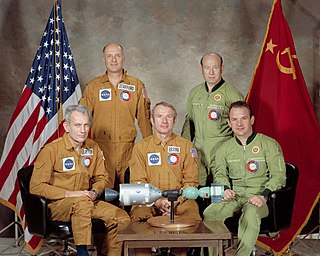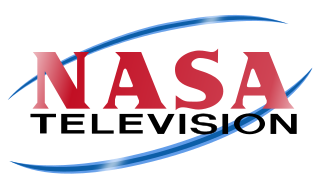Related Research Articles

Apollo 11 was the American spaceflight that first landed humans on the Moon. Commander Neil Armstrong and Lunar Module Pilot Buzz Aldrin landed the Apollo Lunar Module Eagle on July 20, 1969, at 20:17 UTC, and Armstrong became the first person to step onto the Moon's surface six hours and 39 minutes later, on July 21 at 02:56 UTC. Aldrin joined him 19 minutes later, and they spent about two and a quarter hours together exploring the site they had named Tranquility Base upon landing. Armstrong and Aldrin collected 47.5 pounds (21.5 kg) of lunar material to bring back to Earth as pilot Michael Collins flew the Command Module Columbia in lunar orbit, and were on the Moon's surface for 21 hours, 36 minutes before lifting off to rejoin Columbia.

The Apollo program, also known as Project Apollo, was the United States human spaceflight program carried out by the National Aeronautics and Space Administration (NASA), which succeeded in preparing and landing the first men on the Moon from 1968 to 1972. It was first conceived in 1960 during President Dwight D. Eisenhower's administration as a three-person spacecraft to follow the one-person Project Mercury, which put the first Americans in space. Apollo was later dedicated to President John F. Kennedy's national goal for the 1960s of "landing a man on the Moon and returning him safely to the Earth" in an address to Congress on May 25, 1961. It was the third US human spaceflight program to fly, preceded by the two-person Project Gemini conceived in 1961 to extend spaceflight capability in support of Apollo.

Apollo 13 was the seventh crewed mission in the Apollo space program and the third meant to land on the Moon. The craft was launched from Kennedy Space Center on April 11, 1970, but the lunar landing was aborted after an oxygen tank in the service module (SM) ruptured two days into the mission, disabling its electrical and life-support system. The crew, supported by backup systems on the lunar module (LM), instead looped around the Moon in a circumlunar trajectory and returned safely to Earth on April 17. The mission was commanded by Jim Lovell, with Jack Swigert as command module (CM) pilot and Fred Haise as lunar module (LM) pilot. Swigert was a late replacement for Ken Mattingly, who was grounded after exposure to rubella.

Apollo 10 was the fourth human spaceflight in the United States' Apollo program and the second to orbit the Moon. NASA, the mission's operator, described it as a "dress rehearsal" for the first Moon landing. It was designated an "F" mission, intended to test all spacecraft components and procedures short of actual descent and landing.

Apollo 12 was the sixth crewed flight in the United States Apollo program and the second to land on the Moon. It was launched on November 14, 1969, by NASA from the Kennedy Space Center, Florida. Commander Charles "Pete" Conrad and Lunar Module Pilot Alan L. Bean performed just over one day and seven hours of lunar surface activity while Command Module Pilot Richard F. Gordon remained in lunar orbit.

Apollo 14 was the eighth crewed mission in the United States Apollo program, the third to land on the Moon, and the first to land in the lunar highlands. It was the last of the "H missions", landings at specific sites of scientific interest on the Moon for two-day stays with two lunar extravehicular activities.

Apollo 17 was the eleventh and final mission of NASA's Apollo program, the sixth and most recent time humans have set foot on the Moon or traveled beyond low Earth orbit. Commander Gene Cernan and Lunar Module Pilot Harrison Schmitt walked on the Moon, while Command Module Pilot Ronald Evans orbited above. Schmitt was the only professional geologist to land on the Moon; he was selected in place of Joe Engle, as NASA had been under pressure to send a scientist to the Moon. The mission's heavy emphasis on science meant the inclusion of a number of new experiments, including a biological experiment containing five mice that was carried in the command module.

The John F. Kennedy Space Center, located on Merritt Island, Florida, is one of the National Aeronautics and Space Administration's (NASA) ten field centers. Since December 1968, KSC has been NASA's primary launch center of American spaceflight, research, and technology. Launch operations for the Apollo, Skylab and Space Shuttle programs were carried out from Kennedy Space Center Launch Complex 39 and managed by KSC. Located on the east coast of Florida, KSC is adjacent to Cape Canaveral Space Force Station (CCSFS). The management of the two entities work very closely together, share resources and operate facilities on each other's property.

Apollo 13 is a 1995 American docudrama film directed by Ron Howard and starring Tom Hanks, Kevin Bacon, Bill Paxton, Ed Harris, and Gary Sinise. The screenplay by William Broyles Jr. and Al Reinert dramatizes the aborted 1970 Apollo 13 lunar mission and is an adaptation of the 1994 book Lost Moon: The Perilous Voyage of Apollo 13, by astronaut Jim Lovell and Jeffrey Kluger.

STS-3 was NASA's third Space Shuttle mission, and was the third mission for the Space Shuttle Columbia. It launched on March 22, 1982, and landed eight days later on March 30, 1982. The mission, crewed by Jack R. Lousma and C. Gordon Fullerton, involved extensive orbital endurance testing of the Columbia itself, as well as numerous scientific experiments. STS-3 was the first shuttle launch with an unpainted external tank, and the only mission to land at the White Sands Space Harbor near Alamogordo, New Mexico. The orbiter was forced to land at White Sands due to flooding at its originally planned landing site, Edwards Air Force Base.

Charles Moss Duke Jr. is an American former astronaut, United States Air Force (USAF) officer and test pilot. As Lunar Module pilot of Apollo 16 in 1972, he became the 10th and youngest person to walk on the Moon, at age 36 years and 201 days.

Apollo–Soyuz was the first crewed international space mission, carried out jointly by the United States and the Soviet Union in July 1975. Millions of people around the world watched on television as an American Apollo spacecraft docked with a Soviet Soyuz capsule. The project, and its handshake in space, was a symbol of détente between the two superpowers during the Cold War.

Skylab 4 was the third crewed Skylab mission and placed the third and final crew aboard the first American space station.

The Kennedy Space Center Visitor Complex is the visitor center at NASA's Kennedy Space Center on Merritt Island, Florida. It features exhibits and displays, historic spacecraft and memorabilia, shows, two IMAX theaters, and a range of bus tours of the spaceport. The "Space Shuttle Atlantis" exhibit contains the Atlantis orbiter and the Shuttle Launch Experience, a simulated ride into space. The center also provides astronaut training experiences, including a multi-axial chair and Mars Base simulator. The visitor complex also has daily presentations from a veteran NASA astronaut. A bus tour, included with admission, encompasses the separate Apollo/Saturn V Center. There were 1.7 million visitors to the visitor complex in 2016.

Glynn Stephen Lunney was an American NASA engineer. An employee of NASA since its creation in 1958, Lunney was a flight director during the Gemini and Apollo programs, and was on duty during historic events such as the Apollo 11 lunar ascent and the pivotal hours of the Apollo 13 crisis. At the end of the Apollo program, he became manager of the Apollo–Soyuz Test Project, the first collaboration in spaceflight between the United States and the Soviet Union. Later, he served as manager of the Space Shuttle program before leaving NASA in 1985 and later becoming a vice president of the United Space Alliance.

Earthrise is a photograph of Earth and part of the Moon's surface that was taken from lunar orbit by astronaut William Anders on December 24, 1968, during the Apollo 8 mission. Nature photographer Galen Rowell described it as "the most influential environmental photograph ever taken".

NASA's Christopher C. Kraft Jr. Mission Control Center, also known by its radio callsign, Houston, is the facility at the Lyndon B. Johnson Space Center in Houston, Texas, that manages flight control for the United States human space program, currently involving astronauts aboard the International Space Station (ISS). The center is in Building 30 at the Johnson Space Center and is named after Christopher C. Kraft Jr., a NASA engineer and manager who was instrumental in establishing the agency's Mission Control operation, and was the first Flight Director.

NASA TV is the television service of the National Aeronautics and Space Administration (NASA). It is broadcast by satellite with a simulcast over the Internet. Local cable television providers across the United States and amateur television repeaters may carry NASA TV at their own discretion, as NASA-created content is considered a work of the U.S. government and is within the public domain. NASA TV is also available via various cable, satellite, and over-the-top media services worldwide. The network was formally created in the early 1980s to provide NASA managers and engineers with real-time video of missions. NASA has operated a television service since the beginning of the space program for archival purposes, and to provide media outlets with video footage.

Apollo 11 was the first human spaceflight to land on the Moon. In the decades after its 1969 mission took place, widespread celebrations have been held to celebrate its anniversaries.

Apollo 11 is a 2019 American documentary film edited, produced and directed by Todd Douglas Miller. It focuses on the 1969 Apollo 11 mission, the first spaceflight from which men walked on the Moon. The film consists solely of archival footage, including 70 mm film previously unreleased to the public, and does not feature narration, interviews or modern recreations. The Saturn V rocket, Apollo crew consisting of Buzz Aldrin, Neil Armstrong, and Michael Collins, and Apollo program Earth-based mission operations engineers are prominently featured in the film.
References
- 1 2 3 4 Reichhardt, Tony. "Relive the Drama of Apollo 13 in Real Time, As It Happened". Air & Space Magazine. Retrieved 2020-04-11.
- ↑ "Escape Pandemic Dread by Experiencing the Apollo 13 Mission in Real Time". Gizmodo. 11 April 2020. Retrieved 2020-04-11.
- 1 2 3 Baldwin, Catherine (2019-07-12). "Apollo 11 in Real Time, 50 Years Later". NASA. Retrieved 2020-04-11.
- 1 2 "Apollo 11: New website replays first Moon landing mission in real time". Space.com. 2019-06-18. Retrieved 2020-04-11.
- ↑ "Managing the Flood of Space Program Data". www.aps.org. Retrieved 2020-04-11.
- ↑ Feist, Ben. "Digitizing Apollo 17 Part 13 – Apollo17.org – Alpha Release v0.1". Ben Feist. Retrieved 2020-04-11.
- ↑ Feist, Ben. "Digitizing Apollo 17 Part 15 – Apollo17.org v1.0 Launched for the Mission's 43rd Anniversary". Ben Feist. Retrieved 2020-04-11.
- ↑ Feist, Ben. "Digitizing Apollo 17 Part 16 – New Apollo17.org, 44th Anniversary Edition". Ben Feist. Retrieved 2020-04-11.
- ↑ "'Apollo 11 in Real Time' website replays every second of historic mission". Big Think. 2019-07-16. Retrieved 2020-04-11.
- ↑ July 2019, Tariq Malik 20 (20 July 2019). "Relive the Apollo 11 Moon Landing Mission in Real Time!". Space.com. Retrieved 2020-04-11.
{{cite web}}: CS1 maint: numeric names: authors list (link) - ↑ Grush, Loren (2020-03-13). "This website lets you relive Apollo 13 in real time through historical transcripts, footage, and audio". The Verge. Retrieved 2020-04-11.
- 1 2 3 Strickland, Ashley (11 April 2020). "Experience the Apollo 13 mission in real-time during its 50th anniversary". CNN. Retrieved 2020-04-11.
- ↑ "Apollo 13 was a near-disaster that became a triumph — now you can experience it in real time". CBC Radio. Retrieved April 11, 2020.
- ↑ "Apollo 13 in Real Time is now live!". NASA History Office (Twitter). March 13, 2020.